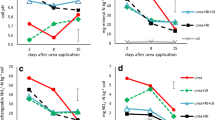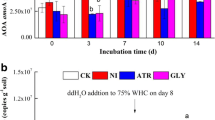Abstract
Urease inhibitors and nitrification inhibitors can reduce nitrogen (N) loss in agriculture soil. However, the effect of inhibitors on soil N2O emissions under the drip irrigation system remains unclear. A pot and a field experiment with two inhibitors were conducted to explore how inhibitors regulate soil nitrogen transformation and N2O emissions. In the pot experiment, three treatments included control, urea, and urea + N-(n-butyl)thiophosphoric triamide (NBPT, urease inhibitor). In the field experiment, three treatments included control, urea, and urea + NBPT + 2-chloro-6-(trichloromethyl)pyridine (nitrapyrin, nitrification inhibitor). The urease inhibition rate in the treatment of urea + NBPT was 27.5% at the 14th day of incubation (pot experiment), and NH4+-N was significantly decreased by 37–64% compared with urea alone treatment. In the field experiment, the nitrification inhibition rate in the treatment of urea + NBPT + nitrapyrin was 47.7 and 63.9% on the 3rd day after fertilization at the wheat heading and filling stages, respectively. Compared to urea treatment, NO3−-N concentration in the double-inhibitor-added treatment was significantly decreased by 32 and 20% on the 5th day after fertilization at the heading and filling stages, respectively; N2O fluxes were also decreased by 30.9 and 33.3% at the two stages of wheat, respectively. In total, adding an inhibitor reduced N loss by 7.39 and 7.44% at the 14th and 35th day in the pot experiment and by 10.53 and 6.65% at the two growing stages of wheat in the field experiment, respectively. Path and correlation analysis showed that N2O emissions were significantly correlated with soil NO3− in both pot and field experiments.




Similar content being viewed by others
References
Abbasi MK, Adams WA (1998) Loss of nitrogen in compacted grassland soil by simultaneous nitrification and denitrification. Plant Soil 200:265–277
Akiyama H, Yan X, Yagi K (2010) Evaluation of effectiveness of enhanced efficiency fertilizers as mitigation options for N2O and NO emissions from agricultural soils: meta-analysis. Glob Change Biol 16:1837–1846
Andersen K, Kjaer T, Revsbech NP (2001) An oxygen insensitive microsensor for nitrous oxide. Sensor Actuat B-Chem 81: 42–48. https://doi.org/10.1016/S0925-4005(01)00924-8
Asgedom H, Kebreab E (2011) Beneficial management practices and mitigation of greenhouse gas emissions in the agriculture of the Canadian prairie: a review. Agron Sustain Dev 31:433–451
Azhar ES, Cleemput OV, Verstraete W (1989) The effect of sodium chlorate and nitrapyrin on the nitrification mediated nitrosation process in soils. Plant Soil 116:133–139
Bao SD (2000) Soil agricultural chemical analysis, third edn. Agriculture Press, Beijing (in Chinese)
Cantarella H, Trivelin PCO, Contin TLM, Dias FLF, Rossetto R, Marcelino R, Coimbra RB, Quaggio JA (2008) Ammonia volatilisation from urease inhibitor-treated urea applied to sugarcane trash blankets. 65:397–401
Cheng Y, Cai ZC, Zhang JB, Lang M, Mary B, Chang SX (2012) Soil moisture effects on gross nitrification differ between adjacent grassland and forested soils in central Alberta, Canada. Plant Soil 352:289–301
Cui M, Sun X, Hu C, Di HJ, Tan Q, Zhao C (2011) Effective mitigation of nitrate leaching and nitrous oxide emissions in intensive vegetable production systems using a nitrification inhibitor, dicyandiamide. J Soils Sediments 11:722–730
Cui P, Fan F, Yin C, Li Z, Song A, Wan Y, Liang Y (2013) Urea- and nitrapyrin-affected N2O emission is coupled mainly with ammonia oxidizing bacteria growth in microcosms of three typical Chinese arable soils. Soil Biol Biochem 66:214–221
Dawar K, Zaman M, Rowarth JS, Blennerhassett J, Turnbull MH (2010) The impact of urease inhibitor on the bioavailability of nitrogen in urea and in comparison with other nitrogen sources in ryegrass ( Lolium perenne L.) Crop Pasture Sci 61:214–221
Dawar K, Zaman M, Rowarth JS, Blennerhassett J, Turnbull MH (2011) Urea hydrolysis and lateral and vertical movement in the soil: effects of urease inhibitor and irrigation. Biol Fert Soils 47:139–146
Di HJ, Cameron KC (2007) Nitrate leaching losses and pasture yields as affected by different rates of animal urine nitrogen returns and application of a nitrification inhibitor—a lysimeter study. Nutr Cycl Agroecosys 79:281–290
Di HJ, Cameron KC, Shen JP, He JZ, Winefield CS (2009) A lysimeter study of nitrate leaching from grazed grassland as affected by a nitrification inhibitor, dicyandiamide, and relationships with ammonia oxidizing bacteria and archaea. Soil Use Manage 25:454–461
Ding WX, Yu HY, Cai ZC (2011) Impact of urease and nitrification inhibitors on nitrous oxide emissions from fluvo-aquic soil in the North China Plain. Biol Fert Soils 47:91–99
FAO STAT (2011). Food and Agriculture Organization statistical database. Accessed Aug 30. Available from: http://faostat.fao.org
Guan SY (1986) Soil enzyme and research method. China Agricutural Press, Beijing, pp. 274–340
Huber DM, Warren HL, Nelson DW, Tsai CY, Ross MA, Mengel D (1982) Evaluation of nitrification inhibitors for no-till corn. Soil Sci 134:388–394
IPCC, 2007. Climate change 2007: understanding and attributing climate change. http://www.ipcc.ch/pdf/assessment-report/ ar4/wg1/ar4-wg1-chapter9.pdf. Accessed 10 Mar 2012
Keerthisinghe DG, Freney JR, Mosier AR (1993) Effect of wax-coated calcium carbide and nitrapyrin on nitrogen loss and methane emission from dry-seeded flooded rice. Biol Fert Soils 16:71–75
Li J, Shi Y, Luo J, Zaman M, Houlbrooke D, Ding W, Ledgard S, Ghani A (2014) Use of nitrogen process inhibitors for reducing gaseous nitrogen losses from land-applied farm effluents. Biol Fert Soils 50:133–145
Li X, Zhang X, Hua X, Cai Z, Yagi K (2009) Methane and nitrous oxide emissions from rice paddy soil as influenced by timing of application of hydroquinone and dicyandiamide. Nutr Cycl Agroecosys 85:31–40
Mahmood T, Ali R, Latif Z, Ishaque W (2011) Dicyandiamide increases the fertilizer N loss from an alkaline calcareous soil treated with 15N-labelled urea under warm climate and under different crops. Biol Fertil Soils 47:619–631. https://doi.org/10.1007/s00374-011-0559-z
Mulvaney RL, Bremner JM (1979) A modified diacetylmonoxime method for colorimetric determination of urea in soil extracts. Commun Soil Sci Plan 10:1163–1170
Osman KT (2013) Plant nutrients and soil fertility management. Springer, Dordrecht, pp 129–159
Ostrom NE, Sutka R, Ostrom PH, Grandy AS, Huizinga KM, Gandhi H, Von Fischer JC, Robertson GP (2010) Isotopologue data reveal bacterial denitrification as the primary source of N2O during a high flux event following cultivation of a native temperate grassland. Soil Biol Biochem 42:499-506. https://doi.org/10.1016/j.soilbio.2009.12.003
Rochester I, Constable G, Saffigna P (1996) Effective nitrification inhibitors may improve fertilizer recovery in irrigated cotton. Biol Fert Soils 23:1–6
Rochette P, Worth DE, Lemke RL, Mcconkey BG, Pennock DJ, Wagnerriddle C, Desjardins RL (2008) Estimation of N2O emissions from agricultural soils in Canada. I. Development of a country-specific methodology. Can J Soil Sci 88:655–669
Saggar S, Jha N, Deslippe J, Bolan NS, Luo J, Giltrap DL, Kim DG, Zaman M, Tillman RW (2013) Denitrification and N2O:N2 production in temperate grasslands processes, measurements, modelling and mitigating negative impacts. Sci Total Environ 465:173–195
Singh J, Kunhikrishnan A, Bolan NS, Saggar S (2013) Impact of urease inhibitor on ammonia and nitrous oxide emissions from temperate pasture soil cores receiving urea fertilizer and cattle urine. Sci Total Environ 465:56–63
Thomson AJ, Giannopoulos G, Pretty J, Baggs EM, Richardson DJ (2012) Biological sources and sinks of nitrous oxide and strategies to mitigate emissions. Philos T R Soc B 367:1157–1168
Watson CJ, Akhonzada NA, Hamilton JTG, Matthews DI (2008) Rate and mode of application of the urease inhibitor N-(n-butyl) thiophosphoric triamide on ammonia volatilization from surface-applied urea. Soil Use Manage 24:246–253
Zaman M, Saggar S, Blennerhassett JD, Singh J (2009) Effect of urease and nitrification inhibitors on N transformation, gaseous emissions of ammonia and nitrous oxide, pasture yield and N uptake in grazed pasture system. Soil Biol Biochem 41:1270–1280
Zhang J, Cai Z, Zhu T (2011) N2O production pathways in the subtropical acid forest soils in China. Environ Res 111:643–649
Acknowledgements
We are grateful to the authors of all those studies from which data were extracted. Thanks are given to Dr. William Gale from America for his helpful comments and revisions.
Funding
This work was supported jointly by the National Key Research and Development Program of China (2017YFC0504302-02) and National Natural Science Foundation of China (41461064).
Author information
Authors and Affiliations
Corresponding author
Ethics declarations
Conflict of interest
The authors declare that they have no conflict of interest.
Additional information
Responsible editor: Zhihong Xu
Rights and permissions
About this article
Cite this article
Tao, R., Li, J., Guan, Y. et al. Effects of urease and nitrification inhibitors on the soil mineral nitrogen dynamics and nitrous oxide (N2O) emissions on calcareous soil. Environ Sci Pollut Res 25, 9155–9164 (2018). https://doi.org/10.1007/s11356-018-1226-9
Received:
Accepted:
Published:
Issue Date:
DOI: https://doi.org/10.1007/s11356-018-1226-9




